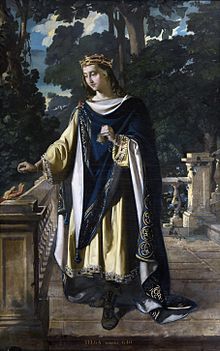Tulga: Difference between revisions
m →Sources: s-end |
m Normalize {{Multiple issues}}: Create {{Multiple issues}} with 3 maintenance template(s): Unreferenced, Expand Spanish, Expand Basque |
||
| Line 1: | Line 1: | ||
{{Multiple issues| |
|||
{{unreferenced|date=February 2011}} |
{{unreferenced|date=February 2011}} |
||
{{Expand Spanish|date=September 2016}} |
{{Expand Spanish|date=September 2016}} |
||
{{Expand Basque|date=September 2016}} |
{{Expand Basque|date=September 2016}} |
||
}} |
|||
[[File:Tulga, rey de los Visigodos (Museo del Prado).jpg|thumb|Imaginary portrait of Tulga by Agustín Sáez Glanadell. Oil on canvas, 1854]] |
[[File:Tulga, rey de los Visigodos (Museo del Prado).jpg|thumb|Imaginary portrait of Tulga by Agustín Sáez Glanadell. Oil on canvas, 1854]] |
||
'''Tulga''' or ''Tulca'' (living 642) was [[Visigoths|Visigothic]] [[Visigothic Kingdom|King]] of [[Hispania]], [[Septimania]] and [[kingdom of Galicia|Galicia]] from 640 to 642, if his father died in December 640, as some sources state. Other sources have his rule beginning as early as 639 or ending as early as 641. He came after his father [[Chintila]] in another vain attempt to establish dynastic kingship. |
'''Tulga''' or ''Tulca'' (living 642) was [[Visigoths|Visigothic]] [[Visigothic Kingdom|King]] of [[Hispania]], [[Septimania]] and [[kingdom of Galicia|Galicia]] from 640 to 642, if his father died in December 640, as some sources state. Other sources have his rule beginning as early as 639 or ending as early as 641. He came after his father [[Chintila]] in another vain attempt to establish dynastic kingship. |
||
Revision as of 22:06, 29 May 2020
This article has multiple issues. Please help improve it or discuss these issues on the talk page. (Learn how and when to remove these template messages)
|

Tulga or Tulca (living 642) was Visigothic King of Hispania, Septimania and Galicia from 640 to 642, if his father died in December 640, as some sources state. Other sources have his rule beginning as early as 639 or ending as early as 641. He came after his father Chintila in another vain attempt to establish dynastic kingship.
In 642, Chindasuinth, a Gothic warlord, who may have been as old as 79, commenced a rebellion. He had command of the frontier with the Basques. He saw the crown's weakness and a convention of nobles (landholding Goths) and the people (other Gothic inhabitants) at Pampalica (probably modern Pampliega) proclaimed him king without the support of the church.
According to Sigebert of Gembloux, the rebel deposed Tulga in Toledo and tonsured him, sending him to live out his days in a monastery, since monks were ineligible for the elective throne. However, Saint Ildephonsus of Toledo says that the rebellion failed without the church's support and Chindasuinth succeeded only on the death of Tulga. From our vantage point, so far in the future, it is impossible to discern the truth.
Before becoming a monk, he was married and had two daughters:
Sources
- El Libro de La Genealogía de Los Reyes de España
Alonso de Cartagena, Bonifacio Palacios Martín, Biblioteca Nacional (Spain), Faustino Menéndez Pidal de Navascués. Contribuidores Bonifacio Palacios Martín, Biblioteca Nacional Editor Scriptorium, 1995 ISBN 84-605-2545-7, ISBN 978-84-605-2545-5
- Roger Collins, Early medieval Spain: unity in diversity, 400-1000 (New York: Palgrave Macmillan, 1995) ISBN 0-312-12662-X, 9780312126629
